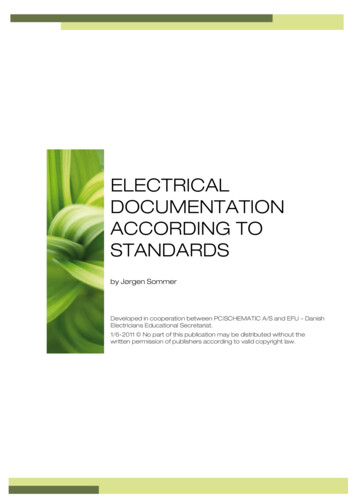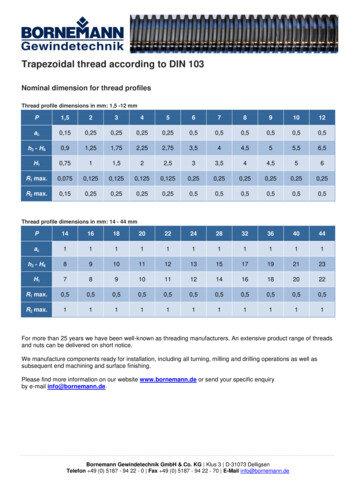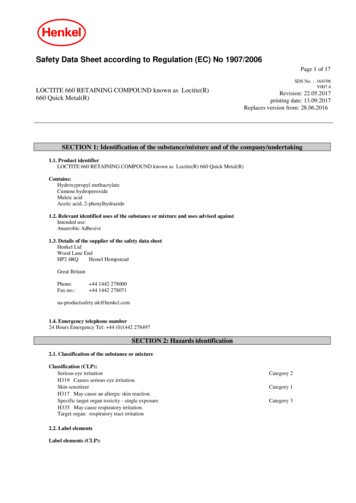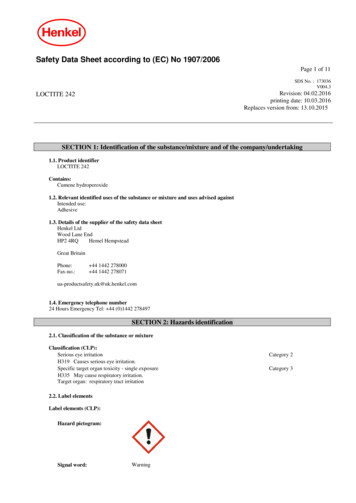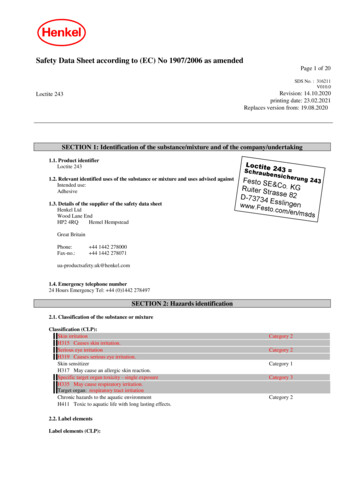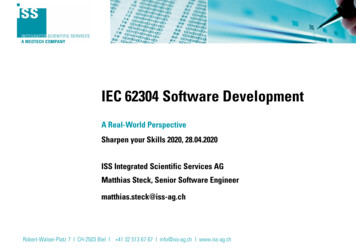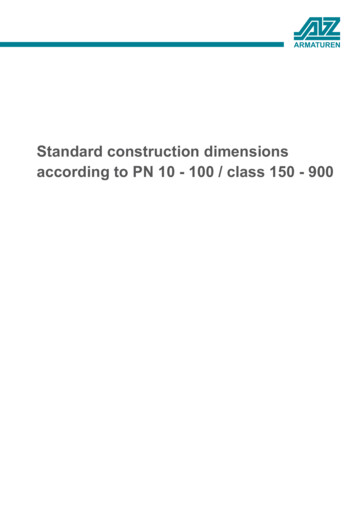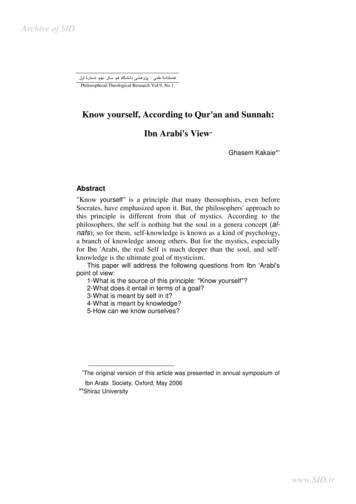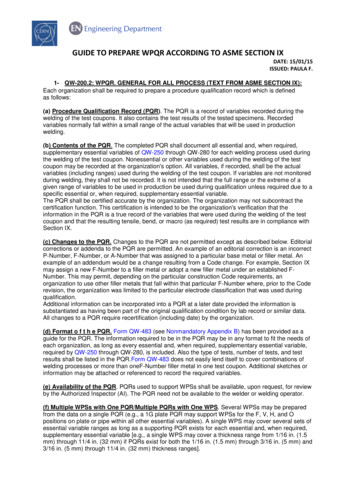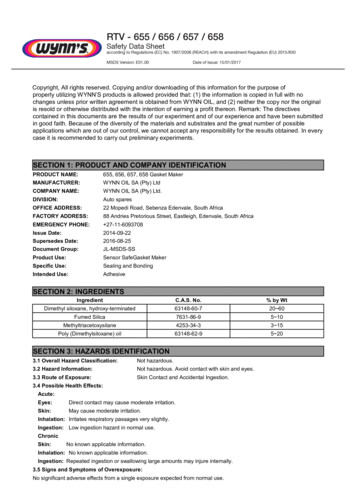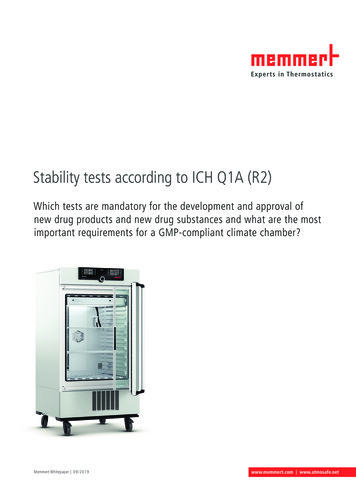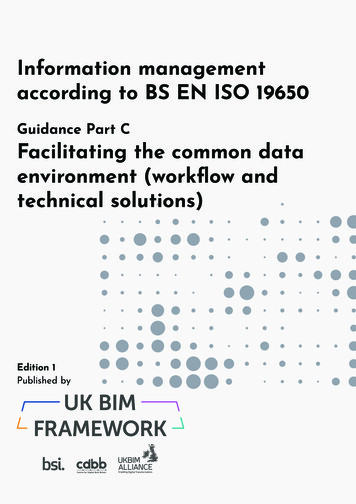
Transcription
Information managementaccording to BS EN ISO 19650Guidance Part CFacilitating the common dataenvironment (workflow andtechnical solutions)Edition 1Published by
EditionsEdition 1September 2020 First release as Guidance C. Note that this guidance textfirst appeared in ISO 19650 Part 2 guidance edition 2.Nothing in this guidance constitutes legal advice or gives rise to a solicitor/client relationship. Specialist legal advice should be taken inrelation to specific circumstances.The contents of this guidance are for general information purposes only.Permission to reproduce extracts from the ISO 19650 series is granted by BSI Standards Limited (BSI) and the copyright in Figure 2 andTable 2 used in this report belongs to BSI. No other use of this material is permitted.British Standards can be obtained in PDF or hard copy formats from the BSI online shop: http://www.bsigroup.com/Shop or by contactingBSI Customer Services for hardcopies only: Tel: 44 (0)20 8996 9001, Email: cservices@bsigroup.comAny data or analysis from this guidance must be reported accurately and not used in a misleading context. If using any informationfrom this report, then its source and date of publication must be acknowledged. COPYRIGHT 2020 the Editors, Authors and Contributors named herein.
1 Guidance Part C Facilitating the common data environment (workflow and technical solutions)Edition 1 - September 2020Table of contentsMessage from the UK BIM Alliance Chair 3Acknowledgments 4About BS EN ISO 19650 5About this guidance document(executive summary) 6Abbreviations and acronyms 81.0 About the common data environment (CDE) 991.1 Introduction 2.0 Components of the CDE 10112.1 Information container states 122.2 Metadata 3.0 Information container management through metadata assignment 13133.1 Metadata management through CDE Solutions 143.2 Transition of metadata between CDE Solutions 4.0 C lassification through metadata assignment 16164.1 Information container classification 164.2 Assigning metadata within CDE solutions 5.0 Revision control through metadata assignment 17185.1 Revision control during Work in Progress (WIP) 195.2 Revision control of Shared information 205.3 Revision control of Published information containers 6.0 S tatus allocation through metadata assignment 21216.1 Status codes 226.2 UK defined standard status codes 236.3 Status codes driving CDE workflow 276.4 Examples of status codes 7.0 Checklist of actions/key points to consider 288.0 Summary 30
2 Guidance Part C Facilitating the common data environment (workflow and technical solutions)Edition 1 - September 2020List of figuresFigure 1: ISO 19650 guidance framework 6Figure 2: CDE concept as demonstrated in ISO 19650-1 Figure 10 11Figure 3: An example of a range of metadata that can be assigned in a cloud basedCDE solution 13Figure 4: Illustration of two different CDE solutions where metadata assignment musttransfer 14Figure 5: Explanation of the 19650-2 National Annex revision system 17Figure 6: Illustration of the benefits of having a WIP version control using the 19650-2 NationalAnnex approach 18Figure 7: Demonstration of WIP and Shared revisions using ISO 19650-2 National Annex approach 19Figure 8: Illustration of how revision metadata distinguishes between different states 20Figure 9: Illustration of an information container transitioning between states 24List of tablesTableTableTableTable1: Abbreviations and acronyms ISO 19650-2 Table NA.1 - Status codes for information containers within a CDE 2: Example of the iterative development of an information container 3: Application of status codes 4: 8222527
3 Guidance Part C Facilitating the common data environment (workflow and technical solutions)Edition 1 - September 2020Message from theUK BIM Alliance ChairAuthor: D r Anne Kemp OBEChair - UK BIM AllianceThe UK BIM Framework provides thefundamental step towards digitaltransformation of the UK’s built environmentindustry. The Framework is based on the ISO19650 series, which first developed out of theUK’s former BIM Level 2, but incorporatesand anticipates global and future digitalperspectives.The UK BIM Framework embraces and assistsin the implementation of the standardsfor managing information for the wholelife of assets of the built environment. TheFramework anticipates the potential forintegration across portfolios. The Frameworkprovides extensive Guidance which continuesto be developed, including the addition ofsupplementary tools and materials to enablea firm basis for the evolving National DigitalTwin Programme.This Guidance has been developed to helpindustry to implement the concepts andprinciples of the ISO 19650 series upon whichthe UK BIM Framework is based. It hasbeen continually updated to keep track ofthe publication of the different parts of ISO19650, and to reflect lessons learnt as furtherexperience is gained in its implementation.The key parts of ISO 19650 are now all inplace, allowing us to realise informationmanagement throughout the whole life ofbuilt environment assets. It provides fortraditional ways of working entailing exchangeof information via files, but also caters forshifts towards data exchange. The key isbeing specific about what information isrequired and how it is to be delivered. Thisneeds forethought around what should bethe “end in mind” and consideration from anorganizational, whole life perspective. Thisthen informs the detailed requirements rightdown to appointment level.The work behind developing this Guidancehas been considerable. I would like to thankSarah Davidson and David Churcher for theirtireless commitment in continuing to bring thiswork together – I so enjoy working with youboth. Secondly, I would like to thank the manyauthors who have contributed so generouslyto the writing of the Guidance – and been sopatient in the criticisms and changes that havebeen required of them. Finally, I would like tothank the many people who have spared timeto review and feedback on the Guidance – theFocus Groups in particular, but also those whohave contacted us separately. Without thisfeedback we would not be able to incorporatethe wide-ranging experience and testing whichis occurring around the industry.We welcome your continued feedback andshared experiences. You can provide this viaguidancefeedback@ukbimframework.org.
4 Guidance Part C Facilitating the common data environment (workflow and technical solutions)AcknowledgmentsThis guidance represents the collaborative efforts ofthe following people and organizationsEditorsDavid ChurcherSarah DavidsonAnne KempHitherwood Consulting LtdUniversity of NottinghamAtkinsAuthorsJohn FordGalliford TryContributorMo Shana’aMortaProductionCentre for Digital Built BritainEdition 1 - September 2020
5 Guidance Part C Facilitating the common data environment (workflow and technical solutions)Edition 1 - September 2020About BS EN ISO 19650The BS EN ISO 19650 series of standards(herein after referred to as the ISO 19650series) is an international standard of goodpractice. It defines information managementprinciples and requirements within abroader context of digital transformationin the disciplines and sectors of the builtenvironment (including construction and assetmanagement industries). Its implementationin the UK is supported by UK NationalForewords in ISO 19650 Parts 1 and 2, and aUK National Annex in ISO 19650 Part 2.The ISO 19650 series replaces some ofthe existing British Standards and PubliclyAvailable Specifications relating toinformation management using buildinginformation modelling (BIM). It is partof a landscape, or ecosystem, of nationaland international standards supportinginformation management processes andtechnical solutions. It considers all informationwhether it is a construction programme, arecord of a meeting, a geometrical model or acontract administration certificate.Building information modelling (BIM) plays akey part in the management of informationbecause it provides a methodology that helpsus to structure information so that technologycan process it.Structuring information using industrystandards helps to improve interoperability.This means that information can be joinedup by both people and technology, whichthen enables us to extract more valuableknowledge from it. Using the sameinformation structures throughout industrygenerates consistency, repetition andpredictability. This brings real efficiencygains for businesses and provides the dataarchitecture for the connected future.Standards within the ISO 19650 series areavailable at www.bsigroup.com.Visit www.ukbimframework.org to see how theISO 19650 standards plus other standardswithin the UK BIM Framework map to thedesign, build, operate and integrate process
6 Guidance Part C Facilitating the common data environment (workflow and technical solutions)Edition 1 - September 2020About this guidance document(executive summary)The guidance framework supports the UKimplementation of the ISO 19650 series.This guidance document (guidance C) sitswithin an overall guidance framework asshown in Figure 1:Guidance C is written to support theimplementation of each published ISO 19650standard.ISO 19650Guidance Part 1ConceptsISO 19650Guidance Part 2Delivery phaseISO 19650Guidance Part 3Operational phaseISO 19650Guidance Part 4(To be confirmed)ISO 19650Guidance Part 5(To be confirmed)ISO 19650Guidance AISO 19650Guidance BISO 19650Guidance CISO 19650Guidance DISO 19650Guidance EISO 19650Guidance FTheinformationmanagementfunction &resourcesOpen data,buildingSMARTand COBieFacilitating theCDE (workflowand tsTendering andappointmentsInformationdeliveryplanningFigure 1: ISO 19650 guidance framework
7 Guidance Part C Facilitating the common data environment (workflow and technical solutions)Who is this guidance written for?This guidance is for people undertaking theinformation management function on behalfof an appointing party (a client) or a leadappointed party (for example, a projectmanager, designer or a main contractor).Who is this guidance of particular interestto and why?This guidance is of interest to the appointingparty, the lead appointed party and each ofthe appointed parties involved in the commondata environment (CDE) in terms of workflowand technical solutions.This first edition of ISO 19650 Guidance Cis written to reflect the recommendationsset out in the National Annex to ISO 196502 published in 2018. The second edition ofthis guidance will be released in 2Q 2021 toaccount for the revised version of the NationalAnnex released in February 2021 (the 2021National Annex).For guidance setting out the changesintroduced in the 2021 National Annex pleaserefer to ISO 19650 Guidance Part 2.Edition 1 - September 2020Key takeaways A CDE is provided and managed by theappointing party (or a third party actingon their behalf), for the management of allinformation containers that are developedand exchanged with the appointing partiesthroughout the project/asset lifecycle fromeach delivery team. The CDE workflow describes the processesto be used for collecting, managing anddisseminating structured and unstructuredinformation, and the CDE solution is thetechnology that enables these processes. Appointing parties, lead appointed partiesand appointed parties could all havetheir own CDE solutions that make up theproject CDE. It is critical to establish metadataassignment and classification and to definehow it can be transferred, retained oraccommodated during the CDE workflow.As with all guidance supporting the UK BIMFramework, we invite comment and feedbackon this guidance C atguidancefeedback@ukbimframework.org
8 Guidance Part C Facilitating the common data environment (workflow and technical solutions)Edition 1 - September 2020Abbreviations and acronymsThis guidance includes a number of abbreviations and acronyms as set out in Table 1.Table 1: Abbreviations and acronymsAbbreviation or acronymTermAIMAsset information modelBIMBuilding information modellingCDECommon data environmentEDMSElectronic document management systemIFCIndustry foundation classesWIPWork in progress
9 Guidance Part C Facilitating the common data environment (workflow and technical solutions)1.0 A bout the common dataenvironment (CDE)1.1 IntroductionThe ISO 19650 Part 1 Concepts guidanceavailable at the UK BIM Framework websiteexplains how the CDE is a combination oftechnical solutions and process workflows.A CDE solution could be software, or it couldbe another form of tool. If information isexchanged by a non-digital solution (forexample, a postal service) and/or stored in anorganized hard-copy cabinet (which may, forexample, be required on a sensitive projectwhere digital methods are not permitted),then this can also be described as a CDEsolution that can be supported by workflows.It is more usual though, for digital solutionslike electronic document management systems(EDMS) to play a big part in implementingCDE solutions and workflows. But, it must berecognized that many different technologiescan be used within a single workflow.ISO 19650-2 envisages that a CDE is providedand managed by the appointing party (ora third party acting on their behalf), for themanagement of all information containersthat are developed and exchanged with theappointing party throughout the life of theproject from each delivery team. This isreferred to in ISO 19650-2 as the project CDE.However, ISO 19650-2 also envisages thatdelivery teams may implement their own(distributed) CDEs as well (but not insteadof the project CDE). This guidance containsexamples of this scenario, which can introducecomplexities into the management ofinformation.Edition 1 - September 2020
10 Guidance Part C Facilitating the common data environment (workflow and technical solutions)2.0 Components of the CDEThere is a potential misconception that theCDE is more about technology and less aboutworkflows. In fact, it is fundamental thatworkflows are developed first and solutionsare selected to facilitate the workflow.It may also be understood that singletechnology solutions dominate projectinformation management. This is not thecase and many solutions exist to deal withdifferent types of project information. Theremay, for example, be document managementtools for design files, contract managementtools that manage commercial information,email management tools for correspondenceand mobile based tools for site qualitydata. Each solution may have multiple anddifferent workflows ensuring that informationis carefully planned, shared, stored, managedand retrieved and that it is timely, correct,complete and consistent.There are various components of the CDEthat this guidance will cover to provide contextfor the reader in understanding the languageof the ISO 19650 series. These include: I nformation States (see section 2.1) Classification of information containers usingmetadata assignment (see section 4.0) Revision control using metadata assignment(see section 5.0) Permitted use of information using metadataassignment (see section 6.0).Edition 1 - September 2020
Guidance Part C Facilitating the common data environment (workflow and technical solutions)Edition 1 - September 20202.1 Information container statesAs an information container develops, itexists in various states. Figure 2 (ISO 19650-1Figure 10) illustrates these states as part ofan information container workflow.SHAREDInformation approved forsharing with otherappropriate task teams anddelivery teams or with theappointing partyCHECK/ REVIEW/APPROVE11This figure is a simplification of the actualprocess and information containers can gothrough different workflows, potentially usingmultiple solutions, as noted elsewhere in thisguidance.WORK IN PROGRESSInformation being developedby its originator or taskteam, not visible to oraccessible by anyone elseTask TeamTask TeamREVIEW/ AUTHORIZETask TeamPUBLISHEDARCHIVEInformation authorized foruse in more detailed design,for construction or for assetmanagementJournal of informationtransactions, providing anaudit trail of informationcontainer developmentFigure 2: CDE concept as demonstrated in ISO 19650-1 Figure 10Did you know .that equivalents to these information container states occur in most information productionprocesses including emails although these are often invisible to the user. For example, if youstart to write an email, this is like Work in Progress. Your email tool may also auto Archive youremails as you progress. Perhaps your email needs to be approved by your manager beforeyou hit send on the final version due to its sensitivity - this is like Share. When you do send theemail to its proper recipient, this is like Publishing it. All whilst yours and the recipient’s emailtools continuously Archive each step of the email trail.It is possible to manage emails and other correspondence related to project delivery via theCDE, and consciously use the CDE workflow and information container states in Figure 2. Theselection of the appropriate items to be managed in this way could be a project specific or adelivery team specific decision. It is suggested that correspondence (including email) with acontractual implication is always managed via the CDE.
12 Guidance Part C Facilitating the common data environment (workflow and technical solutions)2.2 MetadataIt is important to establish what is meantby metadata as the ISO 19650 series offersno formal definition. Metadata is definedas “A set of data that describes and givesinformation about other data” (OxfordDictionary, 2019).To put this into context, the informationcontainer unique ID (see ISO 19650-2National Annex), can be thought of asmetadata because it “describes and givesinformation about other data”. However, ISO19650-2 requires additional metadata to beassigned but it should not be part of theunique ID.The ISO 19650 series makes it clearthat authors keep strict control of theirinformation throughout its development. Itis recommended that this is achieved by theauthor using metadata assignment.This communicates what version theinformation container is at and the purposefor which it can be used.ISO 19650-1 clause 12.1 recommends thefollowing metadata assignment to informationcontainers within a CDE: A revision code A status code.ISO 19650-2 clause 5.1.7 then requires that theCDE enables assignment of these codes plusthe assignment of: A classification code.The scope of the metadata assignment mayexpand beyond the recommendations andrequirements of the ISO 19650 series, forexample to include asset-focused information.Edition 1 - September 2020
13 Guidance Part C Facilitating the common data environment (workflow and technical solutions)Edition 1 - September 20203.0 Information containermanagement through metadataassignment3.1 Metadata management through CDE SolutionsCDE solutions on the market today offervarying degrees of metadata assignmentcapability.Figure 3 illustrates how a CDE solution, in thiscase a cloud based EDMS can have manydifferent metadata assignments against theinformation container.Note that this figure extends metadatabeyond ISO 19650-2 requirements of status,revision and container classification metadata.Container NameDescriptionStatusRevision AuthorSubmittalContainer ClassificationDate7001-BBH-ZZ-ZZ-DR-A-00301First FloorPlanS3P04Joe Blogs12/11/2017PM 40 30 : Design 3C06Joe Blogs12/11/2017PM 40 30 : Design informationContainer Name / ID FieldAdditional Container Metadata AssignmentsFigure 3: An example of a range of metadata that can be assigned in a cloud based CDE solution
14 Guidance Part C Facilitating the common data environment (workflow and technical solutions)Edition 1 - September 20203.2 Transition of metadata between CDE SolutionsThe requirement for metadata createsthe challenge of how the metadata canbe transfer
Facilitating the common data environment (workflow and technical solutions) About BS EN ISO 19650 The BS EN ISO 19650 series of standards (herein after referred to as the ISO 19650 series) is an international standard of good practice. It defines information management principles and requirements within a broader context of digital transformation
